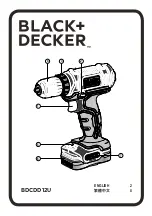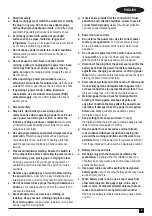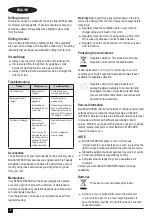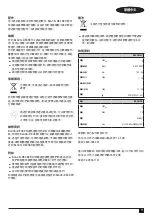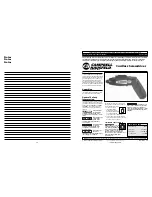
5
ENGLISH
Charging the battery (fig. A)
The battery needs to be charged before first use and
whenever it fails to produce sufficient power on jobs that were
easily done before. The battery may become warm while
charging; this is normal and does not indicate a problem.
Warning!
Do not charge the battery at ambient temperatures
below 10 °C or above 40 °C. Recommended charging
temperature: approx. 24 °C.
Note:
The charger will not charge a battery if the cell
temperature is below approximately 10 °C or above 40 °C.
The battery should be left in the charger and the charger
will begin to charge automatically when the cell tempera-
ture warms up or cools down.
To charge the battery, insert the USB charger (8) (not
supplied) into the Battery.
Plug the charger into a suitable power source and switch
on.
Charge discharged batteries within 1 week. Battery life will
be greatly diminished if stored in a discharged state.
Warning!
fire Hazard. When disconnecting the charger from
the tool, be sure to unplug the charger from the outlet first,
then disconnect the charger cord from the tool.
Fitting and removing the battery
(fig. B)
To fit the battery, line it up with the receptacle on the tool.
Slide the battery into the receptacle and push up until the
battery snaps into place.
To remove the battery, push the release button (7) while at
the same time pulling the battery out of the receptacle.
Operating Instructions
Torque control (fig. C)
This tool is fitted with a torque adjustment collar (3) to select
the operating mode and to set the torque for tightening
screws. Large screws and hard workpiece materials require
a higher torque setting than small screws and soft workpiece
materials.
For drilling in wood, metal and plastics, set the collar to
the drilling position symbol
For screwdriving, set the collar to the desired setting. If
you do not yet know the appropriate setting, proceed as
follows:
Set the collar to the lowest torque setting.
Tighten the first screw.
If the clutch ratchets before the desired result is achieved,
increase the collar setting and continue tightening the
screw. Repeat until you reach the correct setting. Use this
setting for the remaining screws.
Keyless chuck (fig. D)
Warning!
Make certain the lock-off button is engaged to
prevent switch actuation before installing or removing acces-
sories.
To insert a drill bit or other accessory:
Grasp the rear half of the chuck (4a) with one hand and
use your other hand to rotate the front half (4) in the
counterclockwise direction, as viewed from the chuck end.
Insert the bit or other accessory fully into the chuck, and
tighten securely by holding the rear half of the chuck and
rotating the front portion in the clockwise direction as
viewed from the chuck end.
Warning!
Do not attempt to tighten drill bits (or any other
accessory) by gripping the front part of the chuck and turning
the tool on. Damage to the chuck and personal injury may
occur when changing accessories.
Drilling/screwdriving
Select forward or reverse rotation using the forward/re-
verse slider (2).
To switch the tool on, press the switch (1). The tool speed
depends on how far you press the switch.
To switch the tool off, release the switch.
Hints for optimum use
Drilling
Use sharp drill bits only.
Support and secure work properly, as instructed in the
Safety Instructions.
Use appropriate and required safety equipment, as
instructed in the Safety Instructions.
Secure and maintain work area, as instructed in the Safety
Instructions.
Run the drill very slowly, using light pressure, until
the hole is started enough to keep the drill bit from slipping
out of it.
Apply pressure in a straight line with the bit. Use enough
pressure to keep the bit biting but not so much as to stall
the motor or deflect the bit.
Hold the drill firmly with two hands to control its twisting
action.
DO NOT CLICK THE TRIGGER OF A STALLED DRILL
OFF AND ON IN AN ATTEMPT TO START IT. DAMAGE
TO THE DRILL CAN RESULT.
Minimize stalling on breakthrough by reducing pressure
and slowly drilling through the last part of the hole.
Keep the motor running while pulling the bit out of a drilled
hole. This will help reduce jamming.
Make sure switch turns drill on and off.

